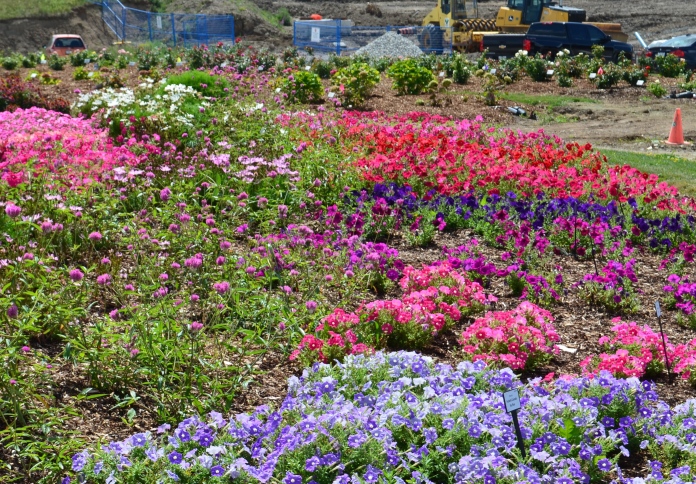What grows brilliantly in southern Ontario? What fails miserably? And what catches the eyes of pro landscapers? I found out last week when I was invited to view the newly expanded University of Guelph/Landscape Ontario trial gardens at the LO office on the outskirts of Milton. There’s nothing glamorous about these gardens. Bordered by the 401 Highway and huge road and building construction projects, the series of large flower beds are designed foremost to put full sun ornamental annuals and perennials to the test. Which can be recommended to garden designers/landscapers, the municipality workers who bring you those eye-popping floral displays in city parks and ordinary, every day gardeners like us?
Even though the main purpose is to figure out the most reliable and pleasing plants in the biz, the flower beds are fascinating, particularly now (August) when a lot of the annuals are flowering their little heads off. There are blankets of eye-searing colour everywhere. And there are plenty of gardening ideas, too, such as planting a long row of Egyptian Papyrus grass (Cyperus papyrus Graceful Grasses® ‘King Tut®’ from Proven Winners) to divide a huge bed and create a soft backdrop for bright annuals.
Pros are looking for plants that will give great bang for their buck and won’t disappoint throughout the growing season. So you won’t find finicky or hard-to-find plants here. In fact, the selection includes a lot of best-sellers from well-known brands such as Ball FloraPlant, Proven Winners and Blooms of Bressingham as well as large Canadian nurseries such as St. Catharines-based J. C. Bakker and Sons Ltd. and Georgetown-based Sheridan Nurseries.
Here’s a short survey of the winners and losers I spotted during my visit and a few easy gardening ideas you can adapt to your garden even if it isn’t the size of a city park.
WINNER: Zinnias get the pros’ thumbs up!
Park designers, landscapers and garden writers alike were asked to vote for the best plants in the trials by planting small coloured flags next to their faves. It seemed everyone gravitated towards the bed of brighter-than-bright zinnias. In particular, the bed containing Solmar Red and Solmar Rose zinnias from Floranova and Zahara XL ‘Fire improved’ zinnia from PanAmerican Seed were bristling with tiny flags by the time everyone had left. (Click on any photo to get full details.) Given the fact that pro landscapers are often looking for dependable plants that can catch the eye with a blanket of colour for most of the growing season, it’s not hard to see why these plants caught a lot of attention.
WINNER: A jewel of a sedum
Garnet Brocade sedum from Proven Winners collected a good number of flags, too. The colour of this plant shone best when the sun came out from behind the passing clouds. Setting this plant against a gorgeous play of echinaceas may have helped to make this plant a real winner, too. For public parks or private gardens, this is a terrific choice because it attracts butterflies and is tolerant of drought, dry, poor and rocky soil and even air pollution.
WINNER: Native bees have a thing for non-native cosmos
I’ve written about how cosmos adds to a sunny garden in surprising ways. Attracting beneficial insects is one of them. In a recent study at these trial gardens on whether pollinators are picky about native or non-native plants, one plant won hands down. Wouldn’t you know the most popular with native honey bees wasn’t a native plant. Non-native Apollo Pink Cosmos was by far the favourite, with non-native Yellow and White Argyranthemums trailing way behind in second with less than half the number of native honey bee visitors.
LOSER: No pep from these unfortunate petunias
Fortunia Purple Gem and Fortunia Coral Gem, both petunias from Dummen Orange, didn’t fair well in the trials this year. Maybe they’re better off as container plants.
GARDEN IDEA: Use annuals like ground cover.
Though some petunias decided to be no-shows at the trials gardens, there were a lot of other petunias and plants equally accustomed to being coddled in containers that were surprisingly going for broke as lush ground covers. (Click on the photos for specific names of plants.)
GARDEN IDEA: Create a tapestry of colour with annuals.
I loved the effect that these plantings of annuals created. I’m not sure whether the garden designer for this trial bed had purposefully planted them to blend together or not but the result is gorgeous.

Superbe Royale Peachy Keen Improved verbena interplanted with Anytime Iris Pansiola, both from Proven Winners.
You don’t have to be a pro to take advantage of this helpful resource for gardeners. The Landscape Ontario trial gardens in Milton are open to the public throughout the season, Monday to Friday during normal business hours. So don’t hesitate to check them out and discover your own landscape winners and losers for your Ontario garden.





















Pingback: Ministry of the fence 10 hottest and oddest 2017 gardening trends
Pingback: 5 wild plants for an edible rain garden | Ministry of the fence